by Winding Pathways | Nov 9, 2023 | (Sub)Urban Homesteading, Mammals, Nature
Update on Furless Tailed Squirrels
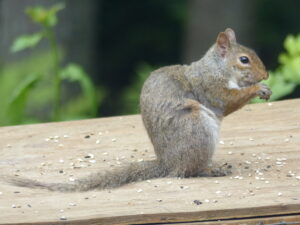
Even in winter, the squirrels’ fur looks healthy…except for their tails.
Two winters ago, we noticed squirrels with nearly furless tails visiting our bird feeders. Our blog about them on Winding Pathways brought hundreds of visitors. Some from other countries! Apparently, we weren’t the only people seeing these hapless animals.
Last winter we had almost no squirrels in the yard. We wonder if the malady that caused them to lose tail fur might have knocked their population way back.
This fall we’re seeing plenty of both fox and gray squirrels in our yard. Their populations have rebounded. And, they have long, furry tails! Squirrels make us happy. While many people don’t like them gobbling seeds at the feeder, we are OK with that and find them as fascinating and fun as cardinals, chickadees, and goldfinches.
Squirrels and the Derecho
Now three years since the disastrous derecho that felled thousands of trees in the Eastern Iowa area, we’re seeing the vital work squirrels do. In the wake of the storm, people planted thousands of trees. Then came three drought years. The National Weather Service placed Cedar Rapids into its exceptional drought category in 2023.
The drought killed many human-planted trees but the ones planted by squirrels are doing just fine. Thanks to them, baby hickories, walnuts, and oaks are poking through the soil in nearby woodlands and our yard.
This fall we’ve watched squirrels carry acorns and walnuts across the yard, dig frantically, and bury their treasure. These enthusiastic gatherers and diggers plan to return during winter’s lean months to retrieve dinner from underground storage. Fortunately, squirrels bury more nuts than they’ll ever need. Unfortunately for them, some of the furry hoarders die with their hidden hoard untouched to sprout in the spring. Squirrels are master tree planters.
-
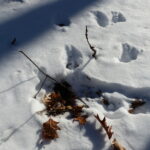
-
Squirrels at work.
-
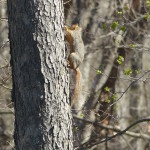
-
What happens when a squirrel falls?
-
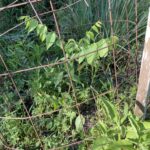
-
This squirrel planted walnut seedling sprouted just this year in spite of the drought.
American Ninjas in the Yard
An oak and a walnut live about 150 feet south of our back deck. Acorns and walnuts are epicurean squirrel delights, and our trees attract the furry acrobats. Squirrels like to use treetops as highways, jumping from one to the next. Our oak and walnut presented them with a problem. There is a several-foot gap between their branch tips. We are fascinated watching the squirrels make the long leap from twig to twig, sometimes leaping up to reach a branch on another tree, often while clutching a nut in its teeth. Their athleticism is astounding. So is their courage.
Squirrels fall. Twice we’ve seen one lose its grip and drop from the top of enormous trees. Both times the furry animals spread eagle their legs and tails while descending and hit the ground with a thump. They are shaken, rest, and then scamper off. A fall that would instantly kill a person, is hardly phased by the squirrels.
This winter we’ll again welcome squirrels to our feeders. They can dine on whole or cracked corn and cobs. We are assured of entertainment with their romps, athleticism and enthusiasm.
-
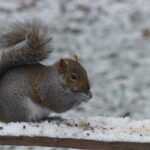
-
Squirrel tails have many uses.
-
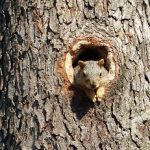
-
It’s a long way down, Mom.
-
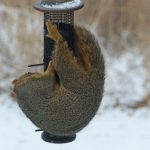
-
Squirrels wolf down seed meant for birds.
by Winding Pathways | Nov 2, 2023 | Travel/Columns
West to Montana
This September, after a more normal Cedar Rapids year (post-derecho, post-COVID, post-surgeries) we headed to the American Prairie Reserve in Montana which we help support. Our compact equipment fit nicely in the Subaru as we headed out on Highway 30. That gave us a great view of wind turbines, especially in western Iowa. We threaded our way up to and through Sioux City to I-90 and crossed South Dakota, pausing at eye-catching rest stops.
The Badlands were smoky from Canadian wildfires the first night we camped but cleared some by the next morning. The spacious tent sites were pleasant, and our lifetime National Park senior passes came in handy.
-
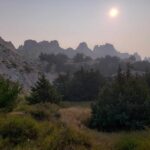
-
Canadian wildfire smoke.
-
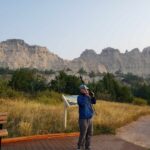
-
Smoke drifted off overnight.
-
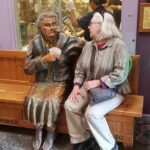
-
Author “visiting” with wooden Wall Drug statue.
We enjoyed the Badlands loop and then just had to stop at iconic Wall Drug and walk through without succumbing to the enticements. We didn’t get ice water but had coffee instead.
The Bighorns in Wyoming.
Such unusual names like Crazy Woman Creek and the Tongue River, had us speculating what might be behind those names. As we passed through the Crow Reservation we thought about the contrasts between Reservation land, with less arable soil, and non-Reservation lands and settlements. The Crow land is large. We noticed some fields with square bales compared to the large, round bales on non-reservation ranches.

The Bighorns loom in the distance.
The second night found us camping in a private campground in southeast Montana north of the reservation. Most private campgrounds are geared toward huge RVs and camping trailers, with few tent spaces. However, we secured a tent spot by a stream and enjoyed showers.
The land changed radically in Montana. Rocky hills with huge hayfields, grazing cattle, and beehives dominated. We saw some sorghum and sunflower fields.
-
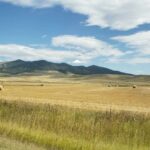
-
Montana is a mix of agriculture and steep hills.
-
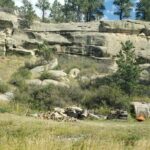
-
Tenting among rocks.
-
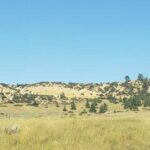
-
Montana’s varied landscape
American Praririe Reserve
We headed west and then north on US 191 to our cabin on the American Prairie Reserve (APR). Small cabins with bunk beds and storage space were seven miles north of the Missouri River. Although we have tent camped many times in bear and cougar country, we were glad to have a rustic cabin. Along with four cabins, there were also about twelve primitive camping sites. We cooked outside.
The well for potable water, with high mineral content, was 2,000 feet deep. We used community showers, toilets, two sinks, and a dishwashing sink/drainer which were very thoughtfully spaced and planned. By hiking trails near the cabins, we learned about prairie ecosystems – grasslands, soil and water, bugs, birds, and animals. As we hiked around the area, prairie dogs gave us hell every time, pipping like crazy. Plenty of scat and some bear paw prints confirmed we were glad to have a cabin to stay in.
-
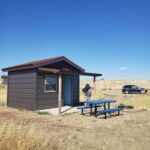
-
Several huts and rustic camp spots invited visitors.
-

-
The tiny cabin kept us warm.
-
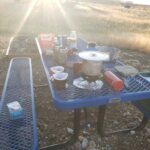
-
We cooked outside.
Little Rockies in the north in this photo. The Lewis and Clark Expedition thought they were the Rockies.
Other trails lace the Reserve. The Upper Missouri River Breaks are west and the Charles M. Russell Wildlife Refuge is south of the American Prairie Reserve with trails.
The evenings were delightful. Gorgeous sunsets glowed for hours. And in the dark sky, a jillion stars shone brightly. We saw constellations we hadn’t seen in years.
-
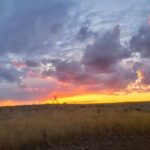
-
Sunsets linger in the open West.
-
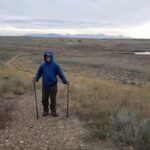
-
Beginning of the Rockies.
-
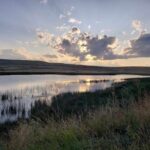
-
Birds flock to wetlands.
Munching in Malta Montana
We enjoyed the tiny, totally packed general store in Zortman hamlet. (3-4 of everything!) We circled the Bowdoin National Wildlife Refuge, a treasure of lakes and wetlands. Here is a sanctuary for resident and migratory birds, many new to us. The water in the area is managed to maintain the lakes and an abundance of artificial islands were established to protect the nesting birds from predators. Stretch’s Pizza in Malta, MT, offered up some of the best vegetarian pizza ever. A welcome change from camp food and one of only two restaurant meals of our trip. The comprehensive Phillips County Museum in Malta gave major space with empathetic attention to both Native people and settlers. Absolutely a not-to-miss stop. And, of course, there was Elvis, the dinosaur, so named because of its perfectly articulated hips, found near Malta.
-
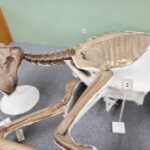
-
Montana houses many ancient artifacts.
-
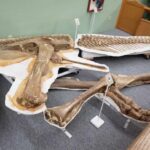
-
The hips swivel like Elvis
After three days at and near APR we headed up to US Highway 2 and Fort Peck. Again, our National Passes helped with expenses. A lovely camping spot below the dam along the Missouri River boasts trails in every direction.
Fort Peck
Fort Peck Dam is the largest hydraulic earth fill dam in the world, producing a billion kilowatts of electricity each year. You read it right, one billion. It was built in about seven years during the Great Depression but hydroelectric production didn’t get started until the early 1950s. It is 21,000 feet long.
-
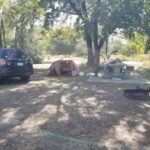
-
Trails radiate out from the campground.
-
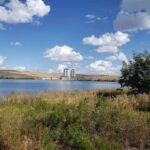
-
Billion kilowatt production
All along the Missouri River from the Breaks to Fort Peck area and around the reservoir is the Charles M. Russell Wildlife Refuge. It has sizable bison/buffalo herds. North of US Hwy 2 and east of the dam is the Fort Peck Indian Reservation where about 800 buffalo roam. We saw antelope, occasionally one but usually up to seven grazing in fields along with the cattle. American Prairie Reserve has the goal of preserving up to 300,000 acres of grassland in Montana which has one of only four sustainable grassland ecosystems in the world. The Reserve staff work with farmers to install wildlife-friendly fences, which have a more flexible, non-barbed wire on the bottom for antelope to cross under safely.
Into the Dakotas
Next, we headed east to North Dakota, and an unusually named town, Home on the Range. Every mile was a feast for the eyes as we drove through the Painted Canyon in Theodore Roosevelt National Park (TRNP) before heading to the south camping unit.
-
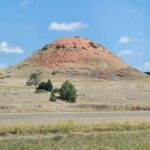
-
Western North Dakota sports splendid colors.
-

-
Animal droppings
-
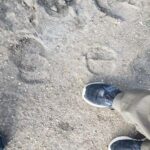
-
compare the sizes!
-

-
Bison make themselves known.
We managed to snag one of the last two camping spots. The wild horses, buffalo, antelope, and elk can all venture into the camping area. We saw evidence of the first two right near our camping spot. Five of the horses thought they might make a visit but campers steered them back into the wilds.
On our way to hike the Paddock Rim trail in the morning, we passed Sagamore Hill, Teddy Roosevelt’s Summer White House. Wild horses grazed in the distance. Bruce compared his foot size to buffalo hoof prints.
Prairie dog towns stretched as far as the eye could see in all directions. These chubby critters were grazing away, fattening up, and storing food for the winter as they do not hibernate. They were less wary than the ones on the American Prairie Reserve.
Agriculture and Open Range
As we drove through Montana, North Dakota, and northern South Dakota, I could not believe how many hay bales in fields and the enormous stacks and rows of bales we saw. We understand they had an unusually rainy summer and so the harvest was plentiful and they will be selling a lot of hay south. We also saw many cattle storm shelters on the ranches, and huge corners of metal or wood on the west and north for cattle to shelter if they get caught in the field during snowstorms. Here is a stock image of a shelter. The ones we saw were 2-4 times this big on a side to shelter a large herd and probably some wildlife, too.
-
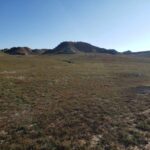
-
Prairie Dogs
-
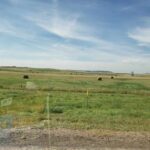
-
Enormous hay bales
-

-
Cattle can huddle in the enclosures in bad storms.
Black Hills
On south to the Black Hills where we camped near Deadwood with the hills behind and mule deer in the campground.
The next day we circled lovely Sylvan Lake which was one of Bruce’s Aunt Gertrude’s favorite spots.
Having seen Rushmore several times with Gertrude, we chose the Needles Highway with plenty of crazy drivers.
Custer Park carefully maintains a herd of about 1400 buffalo so the land is not overgrazed. We visited the buffalo center and learned a mountain of new information and met “Bob” the buffalo.
-
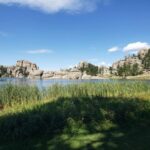
-
A favorite spot in the Black Hills
-
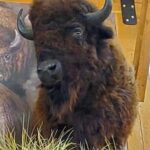
-
Custer State Park maintains a herd of bison
-
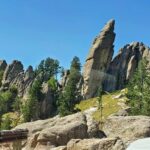
-
spires of the Needles Highway
We headed south to Wind Cave National Park to camp and saw buffalo coming down the hill as we ate supper. With an approaching storm perhaps they were heading to shelter.
Our camp was somewhat sheltered by a hill but we endured the most vivid storm with constant lightning and thunder, and pounding rain we have ever experienced in our tent. Not the windiest but certainly the loudest and most vivid. Obviously, we survived and surprisingly stayed dry. Running to the car would have been deadly.
-
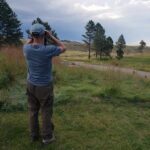
-
A fierce storm sent bison to shelter
-
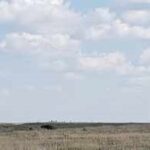
-
Bison
-
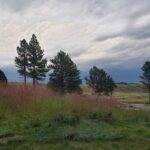
-
Storms kick up quickly in the west.
Our last camping spot before we headed to our farm was on the Niobrara River at Smith Falls State Park near Valentine, Nebraska. What a lovely night with the river rippling by. Smith Falls, is privately owned. However, the owner put in his will a permanent lease to the state so that visitors could experience this treasure. The hike and falls are quite stunning and the state has ensured that anyone can access this special place — totally handicapped accessible.
-
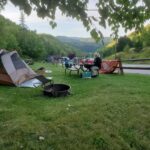
-
Most meals we prepared in camp.
-
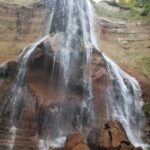
-
This private falls is open to the public.
-
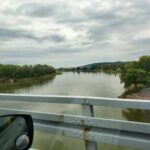
-
We followed and crossed the Missouri River many times.
So, we arrived back in Iowa, realizing we had seen many sections of the Missouri River along the way.
by Winding Pathways | Oct 26, 2023 | (Sub)Urban Homesteading, Garden/Yard, Nature, Trees
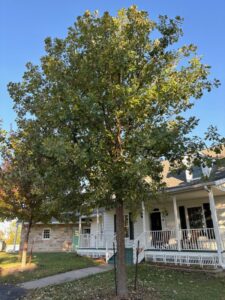
Magnet bur oak in front yard
We didn’t intend to create a magnet when we planted a skinny bur oak in our front yard 13 years ago.
It created a startling experience one October evening when Marion went to the porch to check the weather. A large furry form dropped from the nearby tree and scurried away in the gathering darkness. A woodchuck? Not likely. They work the day shift. Later we caught the mystery animal in the bean of a flashlight as it returned to the magnet tree. A husky raccoon that again retreated in haste when it saw us.
Over the next several days we watched squirrels and woodchucks forage on the acorns. At dusk bucks and does with yearlings eagerly, yet watchfully, gobbled up acorns. In between, turkeys wandered by to forage. Blue jays dropped out of the tree onto the ground and carried off husky acorns to store for winter.
Why Oaks Attract Wildlife
Our October oak was a perfect magnet. While most area oaks were acorn-bare, our youthful front yard tree was loaded with them. They were huge, sweet, and free of the weevils that often consume acorns before exiting through tiny holes.
Blue jays, wild turkeys, woodchucks, raccoons, squirrels, and deer consider October acorns prime carbohydrate-loaded food. When few oaks, scattered around, bear a heavy crop, wild animals beeline to those loaded with nuts. That’s why our tree was a magnet drawing in a stream of wildlife until every acorn was consumed.
-
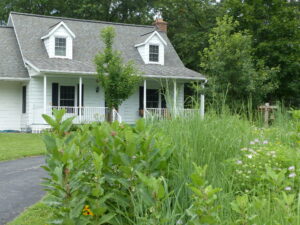
-
Small oak and maple.
-
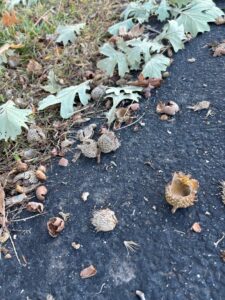
-
Prolific Bur Oak acorns
-
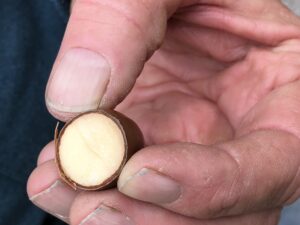
-
White oak acorns have lower tannic acid.
White oak types have leaves with rounded lobes. These include white, bur, and swamp white oaks. Their big acorns are low in tannic acid and are a prized animal and human food. Most trees only bear a heavy crop every few years with acorns that sprout almost as soon as they hit the ground. If not eaten soon weevils find them.
Black oak types have leaves with pointed lobes. Their acorns are loaded with bitter tannin. Often wild animals only feast on them after nearby sweeter white oak-type acorns have all been eaten. Black oak-type acorns wait until next spring to sprout. Perhaps their tannic acid helps them remain uneaten until they sprout months after falling from the tree.
Optimal Places to Plant Oaks
When planted in an ideal location with full sun and rich soil, an oak will begin producing acorns when it’s seven to ten years old. Our front yard tree had a light crop the past few years, but when it reached its 13th year it was loaded with nuts. It was a true magnet that lured wildlife in from far and wide. We enjoyed watching many animals dine on acorns produced by a tree we planted.
by Winding Pathways | Oct 19, 2023 | Nature, Wonderment
Tattoos to You
Recently we have noted people’s tattoos. How fun and meaningful they are. That has not always been the case. Throughout cultures, in eras past, tattoos have been both shunned and venerated. Dating from 5,000 years ago, in Japanese cultures, tatts identified gangs and slaves. Similar to today in different regions of the world.
On the other hand, ancient Egyptian themes centered on fertility and protection in childbirth, the arts and dance.
European Influence
The Picts and Celts of Scotland and Ireland sported fierce body art that duly impressed the Roman soldiers who admired the virile images and feared the fierce warriors.
Europe’s relation with tattoos has been influenced by the several other cultures that invaded over centuries. Again, its fortunes rose and fell as cultures adopted for signs of wealth or as ways to identify slaves. The sordid history of tattoos associated with Nazis soured Americans on tattoos until more recent years. Today, people of all ages and social statuses sport tattoos. Most have special meaning to the person displaying them.
Here are a few we’ve chatted with people about.
-

-
Each a story
-

-
Loving sentiment
-
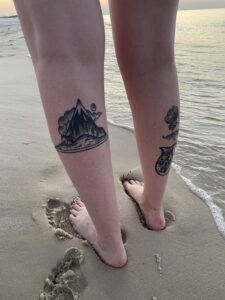
-
Mountains and Vases
Kate started the quest for stories at the recent Outdoor Writers Association of America conference at Gulf Shores, Alabama. When she travels she researches tattoo artists in the cities and countries she plans to visit, scans their electronic portfolios, checks their credentials, and connects with them. From standard to fine lines, and from nature to sayings by loved ones, each tells stories important to her and is a memento of trips.
-

-
Rising
-
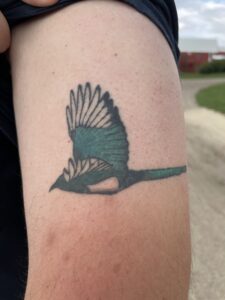
-
Taking flight
Nature themes are popular. The phoenix theme rising again and a nod to the tattoo owner’s children and the magpie is often interpreted as a sign of good luck.
-
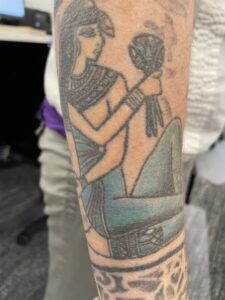
-
Fertility and parenting
-

-
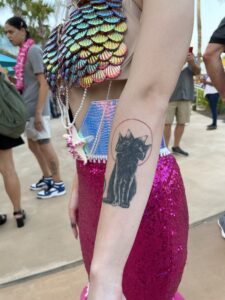
-
Mermaid with tattoo.
Egyptian themes have resonated with librarians and “mermaids!” Harthor, the Goddess of fertility, love, and protection in birth & parenting; the “good luck” scarab beetle; and cats, are always venerated in Egyptian mythology.
-
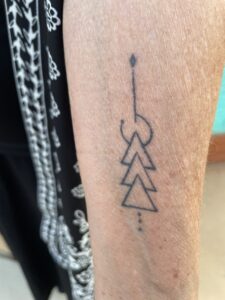
-
All ages enjoy tattoos
-

-
Power Puffs have super powers.
-
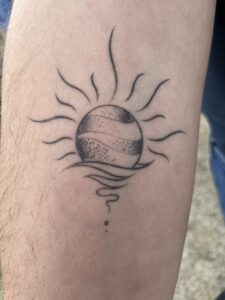
-
This tattoos honors siblings and travel.
-

-
Kansas motto tattoo.
Triangles connect family, Buttercup, of the Powerpuff Girls, the animated TV series from the 1990s inspires humor and superpowers. The State of Kansas motto shines brightly on this man’s arm.
Sailors popularized tattoos in the 1700s when returning from long voyages, especially from the Pacific Islands, sporting elaborate tatts. Of course, soon, royalty had to follow. Purportedly even Winston Churchill and his mother had tattoos.
The popularity of tattoos is on the rise with personalized images and sayings in full display.
by Winding Pathways | Oct 12, 2023 | (Sub)Urban Homesteading, Preparedness
What To Do When No Room At the Inn?
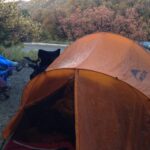
Even bivouac camping can be comfortable.
Basic bivouac camping gear saved our night as we drove along a rainy Ohio Interstate.
We were returning to Iowa from a business trip in New Jersey. The 1000-mile trip is too far for us to make in a day so we normally plan to overnight in a comfortable motel in Ohio or Indiana.
On this recent trip, we didn’t make a reservation in advance, so Marion called motels ahead of us as Rich drove through pelting rain. Bad news. They were all booked for the night.
Bivouac Camping Saved Us!
Our basic bivouac camping gear saved us. Marion spotted West Branch State Park on the map. Not far ahead of us and near the Interstate, we exited just as the downpour subsided. Soon we enjoyed a hot dinner inside a restaurant near our tent.
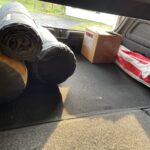
Lightweight camping gear stashed on the sides of the car.
Although we weren’t on a camping trip, we always carry basic bivouac camping gear just in case we run into a situation like our recent one. Modern backpacking gear is lightweight, compact, and effective. It’s essential for a long trail trek but also takes up little space in the car and comes in handy should camping be necessary.
Here’s what we always slip into the car:
- Small nylon tent and ground cloth. Sturdy pegs (spikes or gutter nails are sturdy, don’t bend and so are useful to hold cords to tie a tent down.)
- Lightweight foam mattresses and sleeping bags.
- Folding chairs.
- Cooking and food gear that includes:
* Tiny featherweight butane stove and fuel bottle
* A few backpacking-type meals
* Basic utensils
* Matches! (Remember these!)
Cooking gear and dried meals fit in a small cardboard box and it’s easy to stash the other gear here and there in the car.
-
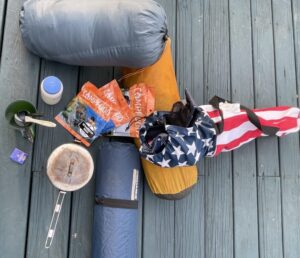
-
Looks like a lot! It’s not!
-

-
Essentials in box
The morning after our unplanned campout we woke well-rested, sipped instant coffee, packed up, found a breakfast cafe, and were soon back on the Interstate heading home.
A Note on Dried Food
Years ago, dried camping food was tolerable but hardly tasty. That’s changed. Modern foods are delicious. We keep two weeks of dried meals in our preparedness bin at home. Should we be impacted by a natural disaster we’d break out our camping stove and enjoy tasty meals. Although this food lasts for years we occasionally eat a few meals at home, on planned camping trips, and during emergencies. Then we restock with fresh meals. We have previously written about preparedness on our blogs.



























































